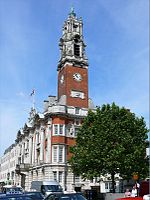Balkerne Gate
Arches and vaults in EnglandBuildings and structures completed in the 1st centuryBuildings and structures in Colchester (town)Buildings and structures in Roman BritainGates in England ... and 4 more
Grade I listed buildings in EssexGrade I listed gatesRoman sites in EnglandTown Gates in England

Balkerne Gate is a Roman gateway in Colchester (the former Camulodunum). It is the largest surviving gateway in Roman Britain and was built where the Roman road from Londinium intersected the town wall of Camulodunum. It is a scheduled monument and a Grade I listed building.
Excerpt from the Wikipedia article Balkerne Gate (License: CC BY-SA 3.0, Authors, Images).Balkerne Gate
Balkerne Hill, Colchester
Geographical coordinates (GPS) Address Nearby Places Show on map
Geographical coordinates (GPS)
| Latitude | Longitude |
|---|---|
| N 51.88966 ° | E 0.89371 ° |
Address
Balkerne Hill
Balkerne Hill
CO3 3AA Colchester
England, United Kingdom
Open on Google Maps









